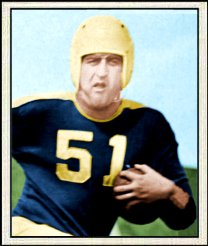

Moving forward from the brink of financial ruin, again, but this time without founder Curly Lambeau, the 1950 Packers opened a sad decade that ultimately would end with great promise. Lambeau saw the waning of his influence and jumped to the Cardinals as head coach on February 1, while Bears assistant Gene Ronzani signed to coach Green Bay five days later. Ronzani would be along young talent scout Jack Vainisi, a host of former Bears players as players and assistant coaches and a new color scheme of green and gold. He would also sign the team’s first black player, end Bob Mann, on November 25 after Mann had been shunned by the league due to a salary dispute. He would not bring a lot of wins, though.
Before Curly left, he conducted one last draft for the Packers and did get value at the top with linebacker Clayton Tonnemaker in the first round and quarterback Tobin Rote in the second. Of broader impact, the All-America Football Conference merged with the NFL after four seasons of war, with the Browns, 49ers and Colts joining the older league. At the dispersal draft held in June, the Packers nabbed former Los Angeles Dons’ halfback Billy Grimes and end Ab Wimberly, along with former Buffalo Bills’ end Al Baldwin and linebacker Carl Schuette. Altogether, just 11 of the 36 men who would play for Green Bay in 1950 had played for the team before. Ronzani tried a clean sweep of the tottering franchise.
The ’50 Packers were a work in progress, though, finishing tied for fifth in the West with a 3-9 record. They scored 244 points, a middling eighth in the league, but allowed 406 (34 points per game), 12th in the 13-team league. Green Bay won two of its first three games, including a home win over the Bears, but only one of its last nine. The Pack was 3-3 at home and 0-6 on the road; 2-2 against losing teams and 1-7 against all others. The only win in the one-year life of the original version of the Baltimore Colts came at the expense of the Packers.
Rookie Tobin Rote completed just 37% of his passes but led the team with 1,231 yards, seven touchdowns and 24 interceptions. Veteran backup Paul Christman chipped in with 545 yards, seven scores and seven picks. Rookie quarterback Tom O’Malley added six more interceptions in the opener against the Lions, his only NFL appearance. That’s 14 TD passes and 37 interceptions total.
Billy Grimes led the team with 480 yards rushing and led the NFL with 55 yards in punt returns, including two for touchdowns. Grimes also led the team with 600 yards in kickoff returns and with 48 points. He had a spectacular season, scoring on punt returns of 68 and 85 yards, a reception of 96 yards and rushes of 57, 61 and 73 yards. Former Bear draftee Breezy Reid was second in rushing with 394 yards.
Al Baldwin was the leading receiver with 28 catches for 555 yards and three scores, including one of 85 yards. Rookie Rebel Steiner snagged seven interceptions, while Baldwin and Wally Dreyer each grabbed five. Steiner set a team record with his 94-yard pick six in the October win over the Bears. Aging Ted Fritsch was second in points with 39, but hit on just three of 17 field goal attempts in his final season.
Rookie Tonnemaker and Grimes were All-Pros, while center Ed Neal was named to the second team. Grimes and Neal were also named to the first Pro Bowl, played in Los Angeles in January 1951.














All custom cards are colorized. Player order of these unlabeled 1950 Bowman style cards is: Tonnemaker, Rote, Grimes, Wimberly, Baldwin, Schuette, Christman, O’Malley, Reid, Steiner, Dreyer, Fritsch, Neal and Mann.





































































